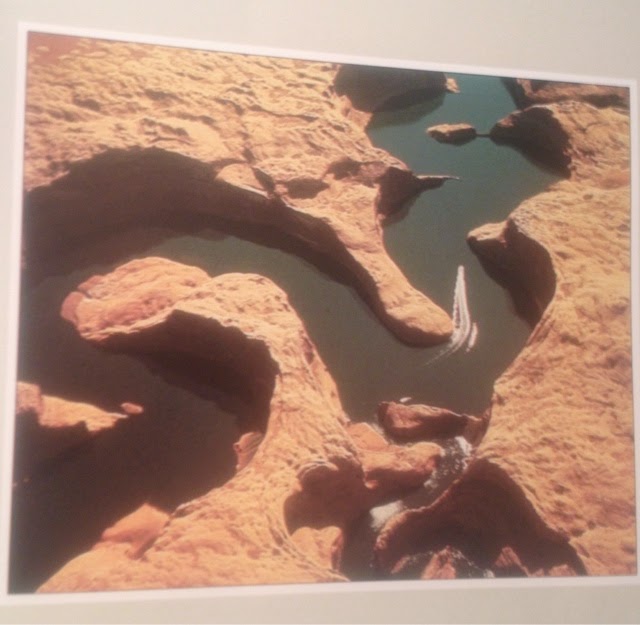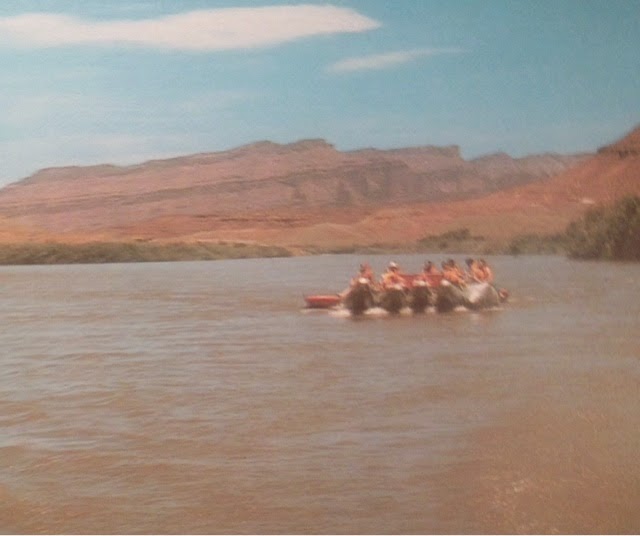The 1980s were the heyday of many things that have now come to pass in the DBWorld: mullets, cassette tapes, cutoffs, bucket boats, fiberglass kayaking, hairboating… and in the quieter places of the soul, the coffee table book. These massive books, now replaced by kindles and an overload of photos on our friends’ Facebook feeds, were once upon a time the only way short of expensive travel to read and SEE far off exotic places of the world. Back then, as today, a trip down the Colorado through the Grand Canyon was an epic dirtbag mission, made even harder then by a paucity of permits (years long waiting lists!) and super expensive raft tours.
Now found only on the shelves of your local resale shop or Half Price Books (I got this copy for $1 at GoodWill), this book is the best of the era at covering the entire River. Masterfully written, the author takes us on an exploration of the sights and history of the Upper and Lower portions of the river as well as the Grand Canyon. Covering the various expeditions, the people who have lived along the banks for centuries, and the flora, fauna, and geology of the region as well as vivid descriptions of the river itself, this book is much more than just a collection of beautiful full color spreads. But it has these in abundance as well, and we’ve shared a few of those photos from the book here with the review. Even though pro-conservation sentiments are voiced within, the finish only hints at the problems facing the Colorado today, now that many years of water mismanagement has wreaked havoc on the river due to over irrigation coupled with drought. In the mid 80s the green spaces in the desert were still considered paradise…
So look around for a copy of this book before you load up the gear for your own descent of the Colorado, or look to it’s pages and photos as you think back on your own missions past. Leave it on the coffee table, and turn off your laptop, and head outside.
EXCERPTS:
…In 1857, Lt Joseph C. Ives attempted to navigate up the Colorado River in a steamboat. He was forced to send the boat back south at the Black Canyon, but he continued overland to the Grand Canyon. His reaction to it was: “The region last explored is, of course, altogether valueless… Ours has been the first, and will doubtless be the last, party of whites to visit this profitless locality. It seems intended by nature that the Colorado River, along the greater portion of it’s lone and majestic way, shall forever be unvisited and undisturbed.”
…It is possible that a prospector named James White inadvertently floated down the Grand Canyon on a {log} raft in an attempt to escape the Indians who had killed his companions, but most historians feel that such a feat would have been impossible, and that White didn’t know where he was. Be that as it may, the journey of Major John Wesley Powell was the first recorded descent, and his journal remains a classic piece of Grand Canyon literature…
…Powell’s description of the junction of the Green and Colorado Rivers would still be accurate today. This is the spot where two impressive rivers become a giant which has created one of the most awesome canyons on the planet. Just below the confluence, as if to show off it’s newly gained might ones, the Colorado has carved out Cataract Canyon, otherwise known as the “Graveyard of the Colorado” for the river-runners’ lives it has claimed…
…At the foot of Cataract Canyon… is the Dirty Devil River, named by Powell and his men: “The water is exceedingly muddy and has an unpleasant odor. One of the men… shouts to Dunn and asks whether it is a trout stream. Dunn replies, much disgusted, that it is ‘a dirty devil,’ and by this name the river is to be known hereafter…
…The drowning of Glen Canyon was a major factor in the first surge of environmental awareness in the early 1960s, and the dam was built with the specific proviso that Lake Powell would not reach Rainbow Bridge… As the largest natural bridge on earth, it has been declared one of the seven natural wonders of the world. But as the waters rose, it became clear that there would be water under that bridge, threatening it’s foundations… and today boaters can float underneath the bridge….
The “dam fever” that ran rampant throughout the United States in the 1930s, 40s, and 50s has abated somewhat… It was, in fact, only a great hue and cry from the public that prevented the Grand Canyon itself from being turned into yet another “lake”…
…Bouyant rubber rafts have made river running a safe and exhilarating experience, but back when the West was first being explored by white men, their roughly-hewn wooden boats weren’t up to the rigors of most mountain rapids… A young and foolish man named Samuel Adams… had rough wooden rowboats built in Breckenridge, CO and began his journey by heading down the Blue River… By the time he reached Gore Canyon, he had lost all of his boats and most of his supplies to the rapids… Adam’s self-righteousness was only given fuel by his notion that nothing in the Grand Canyon could approach the rapids and height of Gore Canyon!








